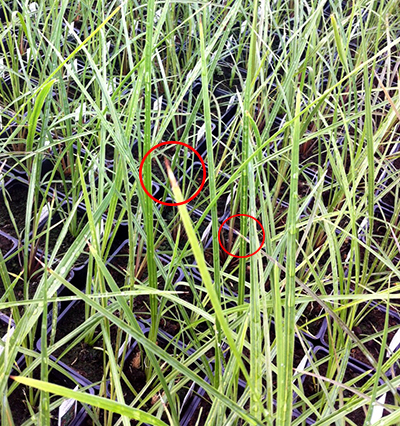Sensitive plants irrigated with city water can develop fluoride toxicity that results in tip burn.
Many municipalities inject fluoride into the water to prevent tooth decay of its residents. However, plants that are irrigated with city water containing fluoride can develop fluoride toxicity (Photo 1). In addition to city water, other sources of fluoride include single superphosphates in the fertilizer and to some extent, perlite.
The symptoms of fluoride toxicity in plants are necrotic regions, especially at the tips and along margins of leaves (Photo 2). Some plants that are more susceptible to fluoride toxicity are monocots, including spider plant, lilies, spikes and dracaena. Furthermore, some of these crops also have long cropping times and therefore will be irrigated with fluorinated water by growers for months, increasing the risk of developing fluoride toxicity.
There are a few things that a grower can do to prevent fluoride toxicity. First, if possible, only use well-water or rainwater to irrigate susceptible crops. For growers irrigating with city water containing fluoride only, be sure your fertilizer is free of fluoride or superphosphates. If the crop will tolerate it and not develop nutrient deficiencies, try to maintain of pH of 6.0 to 6.8 to reduce the availability of fluoride in the growing media. Also, increase the calcium available to the plant to help counteract the effects of fluoride.
For a long-term solution, growers could install a reverse osmosis water filtration system to prevent fluoride toxicity. Another option is to collect and store rainwater and use that alone or to dilute the city water to irrigate susceptible crops.

Photo 2. Tip burn on spikes from fluoride toxicity. Photo credit: Jeanne Himmelein, MSU
Once plants develop necrotic spots on their leaves, the damage is irreversible. The grower could trim off affected leaves or affected necrotic regions after the damage has been done, but that can take a lot of labor. Also, Michigan State University Extension recommends growers monitor the soluble salts in the soil and leach the plants if the salts are high. Growers should not over-water or over-fertilize crops susceptible to fluoride toxicity.
For more information
- Fluorine Toxicity in Plants, Pacific Northwest Plant Disease Management Handbook
- Fluoride Toxicity in Spider Plants, Purdue University
-END-
________________________________________________________________________
From Fluorine Toxicity in Plants:
“Avoiding fluorine toxicity starts with knowing which plants are sensitive. Avoid fluoridated water, high phosphate fertilizers, and low soil pH. An exception would be low pH-loving plants like blueberry. High calcium levels in the soil or rooting medium, such as use of dolomite, can help tie up fluoride and prevent injury.”
* Plant are considered sensitive when injury has been observed on most of the species and when leaf analysis revealed a fluoride content less than 50 ppm. |
||
Table 1. Plants sensitive to fluoride.* |
||
|
Common Name |
Scientific Name |
Notes |
|
Apricot |
Prunus armeniaca |
Some cultivars are intermediate insensitivity. |
|
Box Elder |
Acer negundo |
|
|
Blueberry |
Vaccinium corymbosum |
|
|
Sweet corn |
Zea mays |
|
|
Douglas-fir |
Pseudotsuga menziesii |
|
|
Gladiolus |
Gladiolus sp. |
Bract and leaf injury. |
|
Grape |
Vitis vinifera |
V. labrusca is intermediate. |
|
Oregon Grape |
Mahonia aquifolium |
|
|
Western Larch |
Larix occidentalis |
|
|
Peach |
Prunus persica |
Soft suture or red suture disease of the fruit. |
|
Pine |
Pinus sp. |
Eastern white pine, lodgepole, scotch, Mugho, ponderosa |
|
Plum |
Prunus domestica |
Flowering plums are resistant. |
|
Blue Spruce |
Pice pungens |
|
|
Tulip |
Tulipa sp. |
|
|
Corn plant |
Dracaena sp. |
Most species and cultivars. |
|
Yucca |
Yucca sp. |
|
|
Spider plant |
Chlorophytum comosum |
|
|
Tahitian Bridal Veil |
Gibasis pellucida |
|
|
Lily |
Lilium spp. |
|
References
Camargo, J. A. 2003. Fluoride toxicity to aquatic organisms: a review. Chemosphere, 50:251-264.
Jacobson, J. S. and Hill, A. C. 1970. Recognition of air pollution injury to vegetation: a pictorial atlas. Recognition of air pollution injury to vegetation: a pictorial atlas. The air pollution control association, Pittsburg, Pennsylvania. Information Report No.1
Krupa, S. 2001. Fluorine. In Maloy, O. C. and Murray, T.D. 2001. Encyclopedia of plant pathology. p465.
